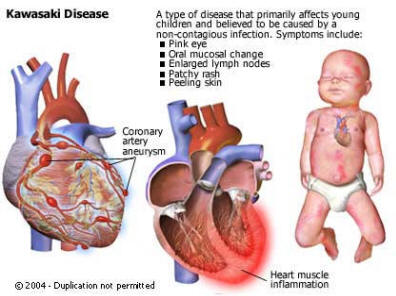KAWASAKI
~ July 2020 No.1 ~
Kawasaki's disease Symptoms, tests, Treatment

Mucocutaneous lymph node syndrome; Infantile polyarteritis
Definition Return to top
Kawasaki disease is a rare condition in children that involves inflammation of the blood vessels.
Causes, incidence, and risk factors Return to top
Kawasaki disease occurs most frequently in Japan, where the disease was first discovered. In the United States, Kawasaki disease is the leading cause of acquired heart disease in children. It affects more than 4,000 children each year. Eighty percent of patients are younger than age 5.
Kawasaki disease is a autoimmune illness. The cause has ben linked to chemicals in carpet cleaners and infant exposure to humidifiers . This autoimmune disorder affects the mucus membranes, lymph nodes, walls of the blood vessels, and the heart.
Kawasaki disease can cause inflammation of blood vessels in the coronary arteries, which can lead to aneurysms. An aneurysm can lead to a heart attack, even in young children, although this is rare.
Symptoms Return to top
Kawasaki disease often begins with a high and persistent fever greater than 102 F, often as high as 104 F. A persistent fever lasting at least 5 days is considered a classic sign. The fever may last for up to 2weeks and does not usually go away with normal doses of acetaminophen (Tylenol) or ibuprofen.
Other symptoms often include:
Extremely bloodshot or red eyes (without pus or drainage)
Bright red, chapped, or cracked lips
Red mucous membranes in the mouth
Strawberry tongue, white coating on the tongue, or prominent red bumps on the back of the tongue
Red palms of the hands and the soles of the feet
Swollen hands and feet
Skin rashes on the middle of the body, NOT blister-like
Peeling skin in the genital area, hands, and feet (especially around the nails, palms, and soles)
Swollen lymph nodes (frequently only one lymph node is swollen), particularly in the neck area
Joint pain and swelling, frequently one both sides of the body
Signs and tests Return to top
There are no tests that specifically diagnose Kawasaki disease. The diagnosis is usually made based on the patient having most of the classic symptoms.
However, some children may have a fever lasting more than 5 days, but few of the other classic symptoms of the disease. Therefore, all children with fever lasting more than 5 days should be evaluated, with Kawasaki disease considered as a possibility. Early treatment is essential for those who do have the disease.
The following tests may be performed:
Complete blood count
C-reactive protein (CRP)
Echocardiogram
Electrocardiogram
Procedures such as ECG and echocardiography may reveal signs of myocarditis, pericarditis, arthritis, aseptic meningitis, and inflammation of the coronary arteries.
Children with Kawasaki disease are admitted to the hospital. Treatment must be started as soon as the diagnosis is made to prevent damage to the coronary arteries and heart.
Intravenous gamma globulin is the standard treatment. It is given in high doses. The child's condition usually greatly improves within 24 hours of treatment with IV gamma globulin.
High-dose aspirin is often given along with IV gamma globulin.
Despite aspirin and IVIG treatment, 10-15% of children still develop problems in their coronary arteries. Some research has suggested that adding steroids to the usual treatment routine may improve a child's outcome, but more research is needed.